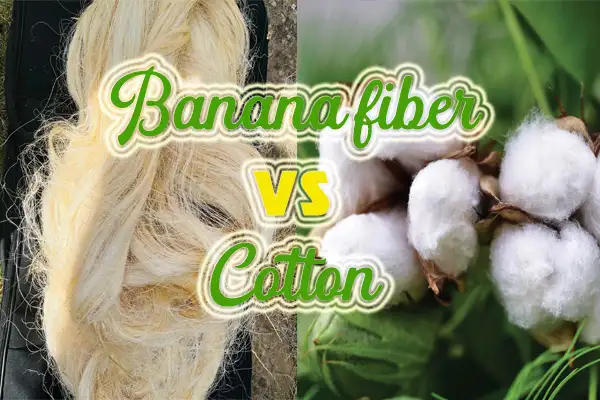Banana fiber and cotton are both natural fibers used in textiles, but they possess distinct properties, benefits, and environmental impacts. Here’s a comprehensive comparison of these two fibers.
1. Source and Production
- Banana Fiber:
- Extracted from the pseudostems of banana plants, which are often considered agricultural waste after the fruit is harvested.
- The production process involves harvesting, extracting, cleaning, and processing the fibers into usable textiles.
- Banana fiber is considered a sustainable option as it utilizes a byproduct of banana cultivation, reducing waste.
- Cotton:
- Derived from the cotton plant’s fluffy seed fibers.
- Cotton cultivation requires significant land, water, and chemical inputs (pesticides and fertilizers), raising concerns about its environmental impact.
- The production process includes planting, harvesting, ginning, and spinning the fibers into yarn.
2. Environmental Impact
- Banana Fiber:
- Sustainability: Banana fiber is biodegradable and renewable. It requires fewer resources to produce compared to cotton.
- Water Usage: The cultivation of banana plants generally requires less water than cotton farming.
- Chemical Use: Minimal chemicals are used in the production of banana fiber, making it an eco-friendly choice.
- Cotton:
- Water Intensive: Cotton is one of the most water-intensive crops, often requiring large amounts of irrigation.
- Pesticides: Conventional cotton farming relies heavily on pesticides and fertilizers, which can lead to soil degradation and water pollution.
- Biodegradability: While cotton is biodegradable, the environmental impact of its cultivation raises sustainability concerns.
3. Physical Properties
- Banana Fiber:
- Strength: Banana fiber is known for its high tensile strength, making it durable and resistant to wear and tear.
- Texture: It has a unique texture that is softer than jute but coarser than silk. This makes it comfortable for clothing while retaining durability.
- Moisture Absorption: While banana fiber absorbs moisture well, it is not as absorbent as cotton.
- Cotton:
- Softness: Cotton is renowned for its softness and comfort against the skin, making it a popular choice for clothing.
- Absorbency: Cotton has excellent moisture-wicking properties and can absorb significant amounts of water, making it comfortable in hot climates.
- Versatility: Cotton can be easily dyed in a wide range of colors and patterns.
4. Cost and Availability
- Banana Fiber:
- Generally less expensive to produce due to its availability as an agricultural byproduct. However, its market availability may be limited compared to cotton.
- The extraction process can be labor-intensive and may require skilled workers.
- Cotton:
- Widely available and produced on a large scale globally. It benefits from established supply chains and economies of scale.
- Prices can fluctuate based on market demand, weather conditions affecting crops, and global trade dynamics.
5. Applications
- Banana Fiber:
- Used in eco-friendly fashion products, home textiles (curtains, rugs), packaging materials, and specialty papers.
- Increasingly popular in sustainable fashion due to its unique properties and minimal environmental impact.
- Cotton:
- Dominates the textile market with applications ranging from clothing (t-shirts, jeans) to home textiles (bed linens, towels).
- Versatile in use but often criticized for its environmental footprint.
Conclusion
Both banana fiber and cotton have their unique advantages and drawbacks. Banana fiber stands out as a sustainable alternative with lower environmental impact, while cotton remains a widely used fiber known for its comfort and versatility. As consumers become more environmentally conscious, banana fiber may gain popularity as an eco-friendly choice in textiles. However, cotton’s established presence in the market means it will continue to play a significant role in the textile industry for the foreseeable future. The choice between these fibers ultimately depends on specific needs regarding sustainability, comfort, cost, and application.


While I appreciate the benefits of banana fiber, I have to say that nothing beats the softness of cotton. It’s just so comfortable for everyday wear. Maybe a blend of both could be the best solution?
As a designer, I’m always looking for unique materials to incorporate into my collections. Banana fiber’s unique texture could add an interesting element to my designs. Can’t wait to experiment with it!
I appreciate the cultural significance of both fibers. Banana fiber has such a rich history in places like Japan and Nepal, while cotton has been a staple in many cultures around the world. Both have their place in textile history.